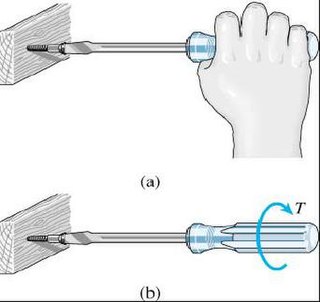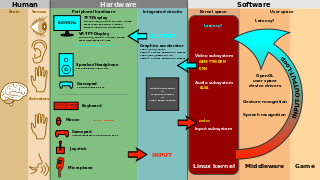
Usability can be described as the capacity of a system to provide a condition for its users to perform the tasks safely, effectively, and efficiently while enjoying the experience. In software engineering, usability is the degree to which a software can be used by specified consumers to achieve quantified objectives with effectiveness, efficiency, and satisfaction in a quantified context of use.
User-centered design (UCD) or user-driven development (UDD) is a framework of process in which usability goals, user characteristics, environment, tasks and workflow of a product, service or process are given extensive attention at each stage of the design process. These tests are conducted with/without actual users during each stage of the process from requirements, pre-production models and post production, completing a circle of proof back to and ensuring that "development proceeds with the user as the center of focus." Such testing is necessary as it is often very difficult for the designers of a product to understand intuitively the first-time users of their design experiences, and what each user's learning curve may look like. User-centered design is based on the understanding of a user, their demands, priorities and experiences and when used, is known to lead to an increased product usefulness and usability as it delivers satisfaction to the user.

In systems engineering, information systems and software engineering, the systems development life cycle (SDLC), also referred to as the application development life cycle, is a process for planning, creating, testing, and deploying an information system. The SDLC concept applies to a range of hardware and software configurations, as a system can be composed of hardware only, software only, or a combination of both. There are usually six stages in this cycle: requirement analysis, design, development and testing, implementation, documentation, and evaluation.
A usability lab is a place where usability testing is done. It is an environment where users are studied interacting with a system for the sake of evaluating the system's usability.
Participatory design is an approach to design attempting to actively involve all stakeholders in the design process to help ensure the result meets their needs and is usable. Participatory design is an approach which is focused on processes and procedures of design and is not a design style. The term is used in a variety of fields e.g. software design, urban design, architecture, landscape architecture, product design, sustainability, graphic design, planning, and health services development as a way of creating environments that are more responsive and appropriate to their inhabitants' and users' cultural, emotional, spiritual and practical needs. It is also one approach to placemaking.
Personalization consists of tailoring a service or a product to accommodate specific individuals, sometimes tied to groups or segments of individuals. Personalization required collecting data on individuals, including web browsing history, web cookies, and location. Companies and organizations use personalization along with the opposite mechanism of popularization to improve customer satisfaction, digital sales conversion, marketing results, branding, and improved website metrics as well as for advertising. Personalization is a key element in social media and recommender systems. Personalization is affecting every sector of society—work, leisure, and citizenship.

A website wireframe, also known as a page schematic or screen blueprint, is a visual guide that represents the skeletal framework of a website. The term wireframe is taken from other fields that use a skeletal framework to represent 3 dimensional shape and volume. Wireframes are created for the purpose of arranging elements to best accomplish a particular purpose. The purpose is usually driven by a business objective and a creative idea. The wireframe depicts the page layout or arrangement of the website's content, including interface elements and navigational systems, and how they work together. The wireframe usually lacks typographic style, color, or graphics, since the main focus lies in functionality, behavior, and priority of content. In other words, it focuses on what a screen does, not what it looks like. Wireframes can be pencil drawings or sketches on a whiteboard, or they can be produced by means of a broad array of free or commercial software applications. Wireframes are generally created by business analysts, user experience designers, developers, visual designers, and by those with expertise in interaction design, information architecture and user research.
Service design is the activity of planning and arranging people, infrastructure, communication and material components of a service in order to improve its quality, and the interaction between the service provider and its users. Service design may function as a way to inform changes to an existing service or create a new service entirely.

User interface (UI) design or user interface engineering is the design of user interfaces for machines and software, such as computers, home appliances, mobile devices, and other electronic devices, with the focus on maximizing usability and the user experience. In computer or software design, user interface (UI) design primarily focuses on information architecture. It is the process of building interfaces that clearly communicates to the user what's important. UI design refers to graphical user interfaces and other forms of interface design. The goal of user interface design is to make the user's interaction as simple and efficient as possible, in terms of accomplishing user goals.
Empathic design is a user-centered design approach that pays attention to the user's feelings toward a product. The empathic design process is sometimes mistakenly referred to as empathetic design.
Contextual inquiry (CI) is a user-centered design (UCD) research method, part of the contextual design methodology. A contextual inquiry interview is usually structured as an approximately two-hour, one-on-one interaction in which the researcher watches the user in the course of the user's normal activities and discusses those activities with the user.
User experience design is the process of defining the experience a user would go through when interacting with a company, its services, and its products. Design decisions in UX design are often driven by research, data analysis, and test results rather than aesthetic preferences and opinions. Unlike user interface design, which focuses solely on the design of a computer interface, UX design encompasses all aspects of a user's perceived experience with a product or website, such as its usability, usefulness, desirability, brand perception, and overall performance. UX design is also an element of the customer experience (CX), which encompasses all aspects and stages of a customer's experience and interaction with a company.
Contextual design (CD) is a user-centered design process developed by Hugh Beyer and Karen Holtzblatt. It incorporates ethnographic methods for gathering data relevant to the product via field studies, rationalizing workflows, and designing human–computer interfaces. In practice, this means that researchers aggregate data from customers in the field where people are living and applying these findings into a final product. Contextual design can be seen as an alternative to engineering and feature driven models of creating new systems.
Guided selling is a process that helps potential buyers of products or services to choose the product best fulfilling their needs and hopefully guides the buyer to buy. It also helps vendors of products to actively guide their customers to a buying decision and thus increases their conversion rate.
Human-centered design is an approach to problem-solving commonly used in process, product, service and system design, management, and engineering frameworks that develops solutions to problems by involving the human perspective in all steps of the problem-solving process. Human involvement typically takes place in initially observing the problem within context, brainstorming, conceptualizing, developing of concepts and implementing the solution.
Living labs are open innovation ecosystems in real-life environments using iterative feedback processes throughout a lifecycle approach of an innovation to create sustainable impact. They focus on co-creation, rapid prototyping & testing and scaling-up innovations & businesses, providing joint-value to the involved stakeholders. In this context, living labs operate as intermediaries/orchestrators among citizens, research organisations, companies and government agencies/levels.
Agile usability engineering is a method created from a combination of agile software development and usability engineering practices. Agile usability engineering attempts to apply the principles of rapid and iterative development to the field of user interface design.
User advocacy is a user experience design principle concerned with representing user perspectives in product design. One definition states that user advocacy is the practice of using designated spokespeople to facilitate interaction between users and designers of the products they use. Another more broadly defines user advocacy as the practice of advocating for the user, regardless of whether one is a user, designer, developer, researcher, manager, etc. User advocates typically may suspend their own personal or functional point of view, and attempt to see the product through the eyes of, and the experience of, the user of that product. The ability to take on the user's point of view, without personal judgement or bias, allows the advocate to see things as the user might see them, enabling them to ultimately make observations and perhaps recommendations to improve the user experience. Similarly, some user advocates will take a neutral, scientific point of view, and will observe and collect data from users that will suggest that the product and/or user experience could be changed or improved in a way that users would prefer or benefit from. User advocates may be scientists or engineers who use the scientific method to make improvements that result in increased ease of use, time savings, improved levels of user satisfaction, or other user-centered metrics.
Contextual application design in digital media is the adaptation of the contextual design process developed by Hugh Beyer and Karen Holtzblatt, in the mobile software space, taking advantage of the measurability of the media, context awareness technologies in mobile devices, aggregation and analytics systems, to create a user-centered design process where developers aggregate data from users' real-world behavior and patterns, and applying these findings into a final product.
Karen Holtzblatt is an American computer scientist known for her contributions in human–computer interaction, and particularly in contextual design. She founded InContext Design in 1992, and is its CEO. Holtzblatt was elected to the CHI Academy in 2007 and won the inaugural ACM SIGCHI Lifetime Award for Practice in 2010. Holzblatt is also affiliated with the University of Maryland, as a research scientist in the Human-Computer Interaction Lab and iSchool.



